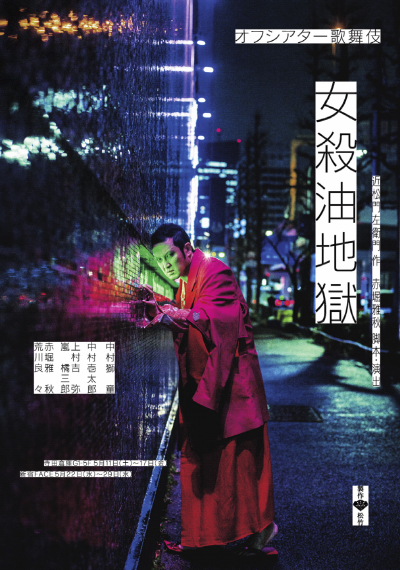| MAY 2019 |
|
5 shows in T˘ky˘ (Kabukiza, National Theatre, Warehouse TERRADA, Shinjuku FACE) and 1 in Ky˘tango (Tango Bunka Kaikan)!
|
| Kabukiza (T˘ky˘) |  |
| Dates | 3 ~ 27 May 2019 Dankikusai Gogatsu ďkabuki Dankikusai May Grand Kabuki |
| MatinÚe | |
| Evening |
Ehon Ushiwakamaru |
| Casting |
Living National Treasure Onoe Kikugor˘, Living National Treasure Nakamura Kichiemon, Ichikawa Ebiz˘, Nakamura Jakuemon, Nakamura Tokiz˘, Onoe Kikunosuke, Onoe Sh˘roku, Ichikawa Sadanji, Ichikawa Udanji, Ichikawa Danz˘, Band˘ Rakuzen, Nakamura Karoku, Nakamura Matagor˘, Nakamura Baishi, Onoe Matsuya, Kataoka Ichiz˘, Band˘ Hikosabur˘, Band˘ Kamez˘, Ichimura Manjir˘, Kawarasaki Gonjűr˘, Ichikawa Kudanji, Nakamura Yonekichi, Nakamura Kash˘, Nakamura Mantar˘, ďtani Hiromatsu, Onoe Ukon, Onoe Ushinosuke |
| Comments |
The great yearly Dankiku festival for the Naritaya and Otowaya guilds, which commemorates 2 great stars of the Meiji era: Dan = Ichikawa Danjűr˘ IX and Kiku = Onoe Kikugor˘ V. This is also the hatsubutai of Onoe Kikunosuke's son Terajima Kazufumi, who is also the grandson of both Living National Treasures Onoe Kikugor˘ and Nakamura Kichiemon. This young boy receives the name of Onoe Ushinosuke VII, a name unheld for 23 years, in May 2019 at the Kabukiza. The new Ushinosuke performs in the dance-drama "Ehon Ushiwakamaru", which was written by the novelist Murakami Genz˘ and was premiered in February 1984 for the hatsubutai of Onoe Ushinosuke VI.
|
 |
| National Theatre (T˘ky˘) |
| Dates | 11 ~ 22 May 2019 Zenshinza Gogatsu K˘en Zenshinza May Performances |
| Program | |
| Casting | |
| Comments |
The usual Zenshinza May program at the National Theatre!
|
 |
| Tango Bunka Kaikan (Ky˘tango) | |
| Dates | 11 ~ 12 May 2019 Band˘ Tamasabur˘ Tokubetsu Buy˘ K˘en Band˘ Tamasabur˘ Special Dance Performances |
| Program |
Yuki Kosunoto Kurokami Yukari no Tsuki |
| Casting |
Living National Treasure Band˘ Tamasabur˘ |
| Comments |
A special Buy˘ program starring the amazing Living National Treasure onnagata Band˘ Tamasabur˘ in Ky˘tango at the Tango Bunka Kaikan (Tango Culture Center).
|
| Warehouse TERRADA (T˘ky˘) | |
| Dates | 11 ~ 17 May 2019 OfushiatÔ Kabuki Off Theater Kabuki |
| Program | |
| Casting |
Nakamura Shid˘, Nakamura Kazutar˘, Kamimura Kichiya, Arashi Kitsusabur˘, Akahori Masaaki, Arakawa Yoshiyoshi |
| Comments |
A new type of Kabuki called OfushiatÔ Kabuki, literally "Off Theater Kabuki", staged at the Warehouse TERRADA and (loosely?) based on Chikamatsu Monzaemon's masterpiece "Abura no Jigoku". |
| Shinjuku FACE (T˘ky˘) | |
| Dates | 22 ~ 29 May 2019 OfushiatÔ Kabuki Off Theater Kabuki |
| Program | |
| Casting |
Nakamura Shid˘, Nakamura Kazutar˘, Kamimura Kichiya, Arashi Kitsusabur˘, Akahori Masaaki, Arakawa Yoshiyoshi |
| Comments |
A new type of Kabuki called OfushiatÔ Kabuki, literally "Off Theater Kabuki", staged at the Shinjuku FACE and (loosely?) based on Chikamatsu Monzaemon's masterpiece "Abura no Jigoku". |
 |
|
|
| Contact | Main | Top | Updates | Actors | Plays | Playwrights | Programs | Links | FAQ | Glossary | Chronology | Illustrations | Prints | Characters | Derivatives | Theaters | Coming soon | News |